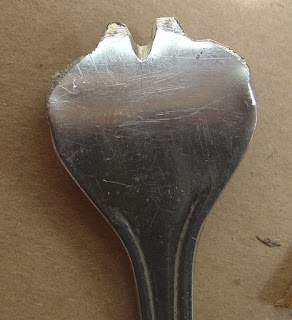1. Edge Beveler
The one tool that sets amateur and professional work apart is the edge beveler. If you have any doubts about that statement, do an experiment with a small project like a keyfob or hair bartette. Do one of each, with the edge finished by beveling, and one without edge beveling. You will see the difference immediately. The edge beveler is a piece of metal with a v shape cut into it, which is sharpened so that it removes the corner along the edge of a cut piece of leather. Some edges can be left unbeveled if they are to be stitched with leather lace, such as with the double loop stitch in calf skin lacing, but most professional leather workers jhave gotten intot the the habit of beveling all edges just as a general proactice. And even if you are lacing the edges with flat lace, beveling will add to the finsihed look, which you can also experiment with on your own using scraps.
The edge beveler has to take a lot of abuse so you will want as heavy duty four-tine fork as you can find. Totally remove the two outside tines, and remove most of the inside two, so that your v shape can be ground there. The sharper you can make that v shape the better the edge beveler will be at cuttong the corners of leaterh. It must be sharpened as illustrated, and that is not tedious or difficult but must be learned to be correctly done. Take the time to do it right and you will have a nice tool which will save you money and you can even have 5 of them if you wanty, in different sizes. Because there are many thicknesses of leather, I highly recommend that you make as many as you need for the various leather thicknesses in your work.
Put a good wooden handle about three or four inches long onto the shortened fork handle, and fasten with good epoxy. You will have to learn to use your own tool to its maximum, for whatever you are doing, ut it can be done quickly, the learning i mean, and is not too hard to do.The wooden handle can be shaped by whittling or grinding and sanding or both. If whittling, do be careful. All knives should always be respectfully handled, especially when you are applying force to them.
The one tool that sets amateur and professional work apart is the edge beveler. If you have any doubts about that statement, do an experiment with a small project like a keyfob or hair bartette. Do one of each, with the edge finished by beveling, and one without edge beveling. You will see the difference immediately. The edge beveler is a piece of metal with a v shape cut into it, which is sharpened so that it removes the corner along the edge of a cut piece of leather. Some edges can be left unbeveled if they are to be stitched with leather lace, such as with the double loop stitch in calf skin lacing, but most professional leather workers jhave gotten intot the the habit of beveling all edges just as a general proactice. And even if you are lacing the edges with flat lace, beveling will add to the finsihed look, which you can also experiment with on your own using scraps.
The edge beveler has to take a lot of abuse so you will want as heavy duty four-tine fork as you can find. Totally remove the two outside tines, and remove most of the inside two, so that your v shape can be ground there. The sharper you can make that v shape the better the edge beveler will be at cuttong the corners of leaterh. It must be sharpened as illustrated, and that is not tedious or difficult but must be learned to be correctly done. Take the time to do it right and you will have a nice tool which will save you money and you can even have 5 of them if you wanty, in different sizes. Because there are many thicknesses of leather, I highly recommend that you make as many as you need for the various leather thicknesses in your work.
Put a good wooden handle about three or four inches long onto the shortened fork handle, and fasten with good epoxy. You will have to learn to use your own tool to its maximum, for whatever you are doing, ut it can be done quickly, the learning i mean, and is not too hard to do.The wooden handle can be shaped by whittling or grinding and sanding or both. If whittling, do be careful. All knives should always be respectfully handled, especially when you are applying force to them.




This comment has been removed by the author.
ReplyDelete